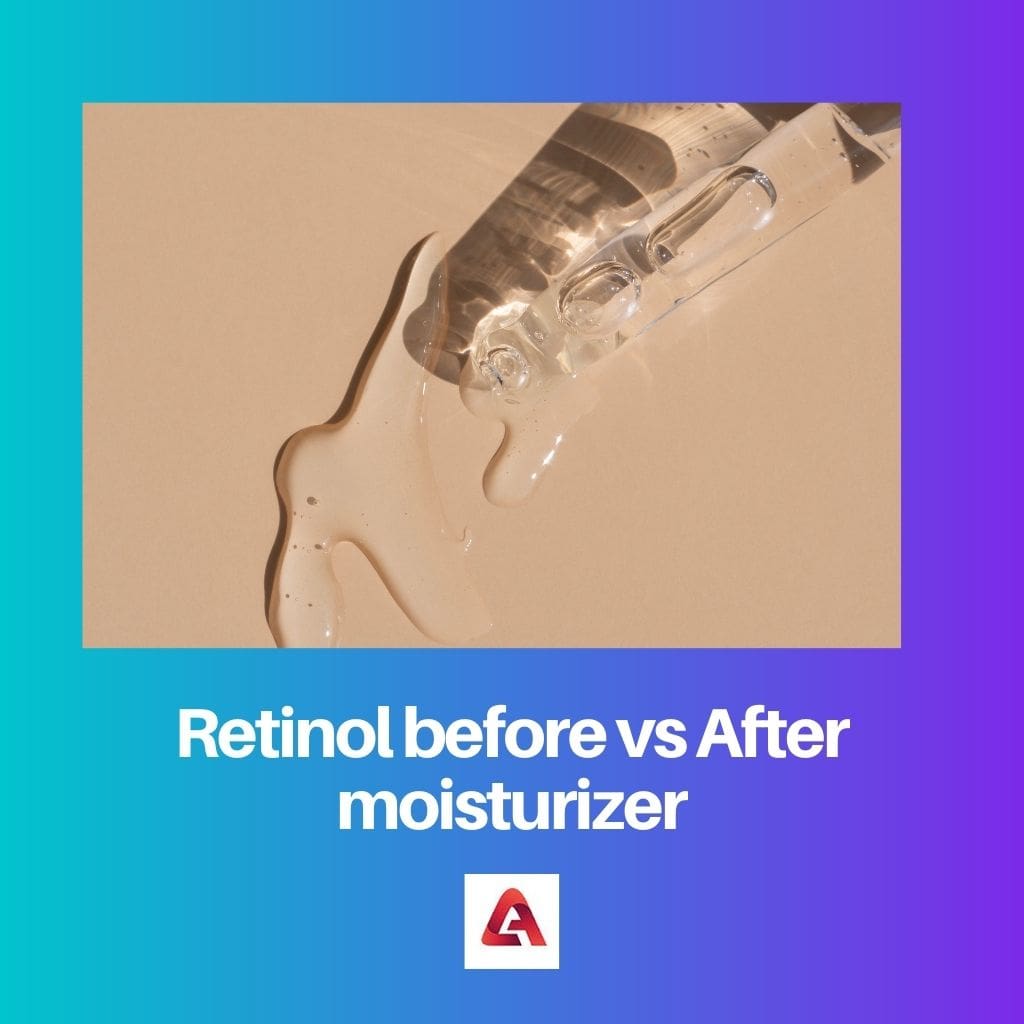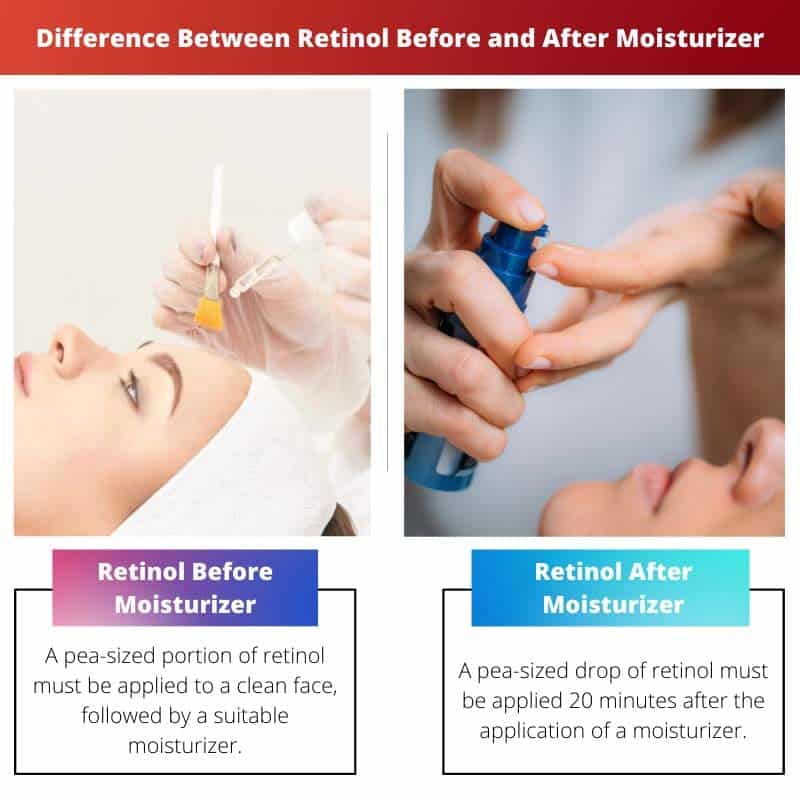The skin needs to be completely dry before the application of retinol. Moreover, one must wait for the product to be completely absorbed before applying the moisturizer.
Retinol after moisturizer entails the application of a layer of moisturizer on the face, followed by applying retinol after an interim period of at least 20 minutes. This allows the moisturizer to be absorbed by the skin and prevents retinol burns from occurring on excessively sensitive skin types.
Key Takeaways
- Retinol is a form of vitamin A used in skincare to reduce the appearance of fine lines, wrinkles, and uneven skin tone; applying retinol before or after moisturizer can impact its effectiveness.
- Applying retinol before moisturizer allows it to penetrate the skin more effectively; applying it after moisturizer can create a barrier that reduces absorption.
- Moisturizer helps to soothe and hydrate the skin, minimizing the potential for retinol-induced irritation or dryness.
Difference Between Retinol Before and After Moisturizer
Retinol is a potent ingredient that can help reduce the appearance of fine lines and wrinkles, improve skin texture, and increase cell turnover. Applying retinol after your moisturizer in your skincare routine is not recommended. This is because moisturizers can create a barrier on the skin that can reduce the absorption of retinol.

Comparison Table for Retinol Before vs. After Moisturizer
| Parameters of Comparison | Retinol Before Moisturizer | Retinol After Moisturizer |
|---|---|---|
| Technique of Application | A pea-sized portion of retinol must be applied to a clean face, followed by a suitable moisturizer. | A pea-sized drop of retinol must be applied 20 minutes after a moisturizer. |
| User Suitability | Retinol before moisturizer is more suited for experienced users. | Retinol after moisturizer is more suited for novice users. |
| Skin type | Suitable for all skin types, but maybe potentially harmful to sensitive skin. | Most suitable for sensitive skin. |
| Retinol Potency | The potency of retinol is retained as the skin is completely dry and the product is not diluted. | The potency of retinol may be diluted due to the prior application of a moisturizer. |
| Retinol Burns | Retinol burns- causing redness, flaky skin, and irritation- may be produced on excessively sensitive skin. | Retinol burns can be effectively avoided by this method of application. |
What is Retinol Before Moisturizer?
Retinol is a wonder drug used to rejuvenate one’s skin. As a vitamin A derivative, retinol belongs to the group of retinoids.
Renowned for its effective anti-aging and skin revitalization qualities, retinol is widely used as a core ingredient in several anti-aging creams and serums.
However, there is an everlasting debate about the proper method of using retinol. People are confused by the issue of determining the right chronological inclusion of retinol in their skincare regimes.
The key question is -should it be applied before or after moisturizing your skin?
Some beauty blogs suggest the correct incorporation of retinol in your skincare routine before applying a moisturizer. Begin your skincare routine by washing your face with a suitable face wash or cleanser.
Pat it dry – your face must retain no dampness for the retinol to work effectively. Take a pea-sized portion of retinol in your palm and massage it onto your face.
If you are a novice user, using retinol in sparing quantities is always advisable, giving your skin time to adjust to the product. Also, one must remember to dry the area completely before application because if any moisture is left behind, it can enhance skin irritability after the retinol application.
This risk can also be effectively reduced by applying a well-suited moisturizer. The moisturizer application after retinol will ensure that your skin remains hydrated.
This is the preferred application method when your skin has fully adjusted to the new product.
How to Use Retinol Before Moisturizer?
Preparation
Preparing the skin before applying retinol is crucial for optimal results. Start by cleansing your face with a gentle cleanser and ensure your skin is completely dry. Apply a moisturizer to create a protective barrier. Use a pea-sized amount of retinol and gently apply it to your face, avoiding the eye and mouth areas.
Allow the retinol to absorb before continuing with your skincare routine. Always follow up with sunscreen during the day to protect your skin. Gradually increase retinol concentration and consult a dermatologist for personalized advice.
Application Tips
To ensure optimal application of retinol before moisturizer, follow these tips:
- Begin with a clean, dry face to maximize absorption and effectiveness.
- Use a small amount, a pea-sized portion, to cover your entire face.
- Prioritize problem areas, such as fine lines or wrinkles, by applying retinol directly to those regions.
- Apply gently and avoid harsh rubbing or tugging, as retinol can irritate the skin.
- Allow the retinol to absorb a few minutes before applying moisturizer to avoid dilution or interference.
- Choose a moisturizer suitable for your skin type that complements retinol use, providing hydration and protection.
- Follow a specific layering order: retinol first, then allow it to absorb, and finally, apply moisturizer.
Precautions and Side Effects
Precautions
Taking precautions for optimal results and minimizing potential side effects is important when using retinol before moisturizer. Start by patch-testing a small area of skin to check for sensitivity. Begin with a lower concentration of retinol and gradually increase as tolerated. Follow the instructions provided with the product regarding application amount and frequency.
Protect your skin from sun damage by using sunscreen daily and limiting sun exposure. Apply a gentle, hydrating moisturizer to reduce dryness and irritation after the retinol has been absorbed. Avoid sensitive areas like the eyes, lips, and corners of the nose. Consult a dermatologist for personalized advice if you have specific concerns or uncertainties. By following these precautions, you can safely incorporate retinol into your skincare routine.
Side Effects
Using retinol before a moisturizer can lead to potential side effects. These include dryness, peeling, and flaking, especially with higher concentrations or inadequate moisturization. Irritation, redness, and sensitivity can occur, particularly during the initial stages or with stronger formulations. Retinol increases sun sensitivity, necessitating high SPF sunscreen and limited sun exposure.
Temporary breakouts or congestion, known as purging, may also occur as retinol speeds up cell turnover. Other products may cause additional sensitivity when combined with retinol. Delicate areas like the eyes, lips, and corners of the nose are particularly prone to discomfort. Should severe or persistent side effects arise, discontinue use and consult a dermatologist. They can offer personalized advice based on your skin type and concerns to address issues effectively.
What is Retinol After Moisturizer?
Retinol after moisturizing your skin is equally favorable. Dermatologists have stated that applying retinol after moisturizing your skin minimally compromises the absorption and efficacy of the product.
Dermatologists prefer this method for patients with excessively sensitive skin.
The routine entails washing your face with a well-suited face wash. Apply a skin-type appropriate moisturizer.
The catch here is to let the moisturizer set in and get absorbed into the skin. Do not apply the retinol directly after the moisturization regime.
After 20 minutes, apply a pea-sized portion of retinol. This will reduce the concentration of the product and prevent possible skin irritation.
Retinol burn can cause severe irritation, redness, and flaky skin. The key to preventing such a painful and adverse reaction to the new, strong retinol regime is moisturizing the skin before applying the product.
If retinol burns occur on sensitive skin, treat them with cleansers and moisturizers. Stop the application of the product until the burns have healed completely.
How to Use Retinol After Moisturizer
Using retinol after moisturizer can be an alternative approach for those with sensitive skin or those who experience excessive dryness or irritation when using retinol alone. Here’s a step-by-step guide on how to use retinol after moisturizer:
Step 1: Cleanse Your Face
Start by cleansing your face with a gentle cleanser to remove dirt, oil, or makeup. Use lukewarm water and a mild cleanser suitable for your skin type. Pat your face dry with a clean towel.
Step 2: Apply Moisturizer
After cleansing, apply a generous moisturizer to your face and neck. Choose a moisturizer that is hydrating, non-comedogenic, and suitable for your skin type. Allow the moisturizer to fully absorb into your skin before proceeding to the next step.
Step 3: Apply Retinol
Take a pea-sized amount of retinol cream or serum onto your fingertips. Gently apply the retinol to your face, focusing on areas of concern such as fine lines, wrinkles, or hyperpigmentation. Avoid the delicate eye and mouth areas unless specifically directed by a dermatologist.
Tips for Using Retinol After Moisturizer
When using retinol after moisturizer, here are some helpful tips to ensure effective and safe application:
Tip 1: Start Slowly
If you’re new to using retinol or have sensitive skin, it’s best to start with a lower concentration and gradually increase it over time. This allows your skin to adjust and minimizes the risk of irritation or dryness. Begin with applying retinol after moisturizer a few times a week and then gradually increase the frequency as tolerated.
Tip 2: Use Sunscreen
Retinol can increase sun sensitivity, even when applied after moisturizer. To protect your skin from harmful UV rays, apply a broad-spectrum sunscreen with a high SPF during the daytime. This helps prevent sunburn and further skin damage.
Tip 3: Avoid Other Active Ingredients
When using retinol after moisturizer, it’s advisable to avoid using other active ingredients that may increase the potential for skin irritation. This includes exfoliants, acids, or other potent treatments. Simplify your skincare routine and focus on the retinol and moisturizer combination to minimize the risk of adverse reactions.
Main Differences Between Retinol Before and After Moisturizer
- The application technique is the main difference between applying retinol before and after moisturizer. While applying retinol before moisturizing your face would entail taking a pea-sized amount of the product and applying it on a clean, dry face, followed by a layer of moisturizer; the latter includes the application of retinol at least 20 minutes after the moisturizer has been absorbed into the skin.
- Retinol before moisturizer may be better suited for experienced users as adverse reactions to the strong retinol formula are avoided due to prolonged usage. Retinol after moisturizer may be better suited for novice users as the skin may take some time to adjust to the product.
- The latter approach may be better suited for sensitive skin variants as it reduces the possibility of skin irritation. For normal skin types, the former may be implemented successfully.
- The former approach does not reduce the potency of retinol as the product is not diluted by the moisturizer applied later on. The latter approach may dilute the efficacy of retinol as the moisturizer applied before retinol dilutes the product.
- Retinol burns can range from skin irritations to redness and flakiness. These may be commonly experienced by people with sensitive skin using the former method. The latter method reduces the possibility of retinol burns.




